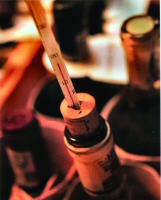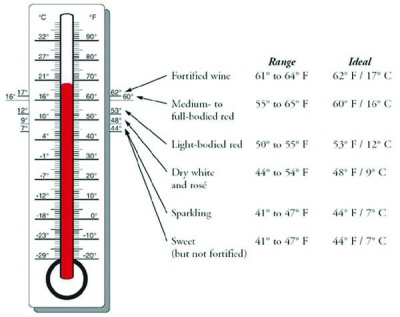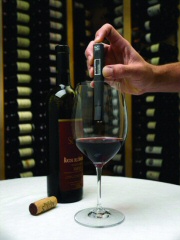|
 There's no mystery to serving wine, right? Just open the bottle and pour. Of course you know that serving a wine with the appropriate foods can help to enhance flavors and qualities of the wine- a juicy char-grilled steak with a big, bold Cabernet Sauvignon or broiled salmon filet with a buttery Chardonnay. You may even think about decanting a wine to let it "breathe" before serving it. But did you know that serving wine at the right temperature has an important impact on how it will taste? It can make the difference between a mediocre, flat wine and a superbly full and smooth one. There's no mystery to serving wine, right? Just open the bottle and pour. Of course you know that serving a wine with the appropriate foods can help to enhance flavors and qualities of the wine- a juicy char-grilled steak with a big, bold Cabernet Sauvignon or broiled salmon filet with a buttery Chardonnay. You may even think about decanting a wine to let it "breathe" before serving it. But did you know that serving wine at the right temperature has an important impact on how it will taste? It can make the difference between a mediocre, flat wine and a superbly full and smooth one.
Two common mistakes when serving wine are serving white wines too cold and red wines too warm. When served too warm, white wines can taste alcoholic and limp, while whites too cold will be refreshing but nearly tasteless. Serve reds too warm and they will taste soft, alcoholic and even vinegary but reds too cold can take on a tannic bite and have much less flavor. The effect serving temperature has on how a wine's tastes cannot be overestimated. The fact is, properly chilled wines do taste better. Here's how to be confident the wine you serve will be at its best.
By serving wine at the proper temperature you can enhance its flavors, aromas and fully experience everything the bottle has to offer. Generally, white wines should be served chilled, but different styles require varying levels of coldness. Cooler serving temperatures bring out acidity and crisp refreshing flavors. Generally, Sauvignon Blanc, Pinot Grigio, white Zinfandel and rosés should be chilled to refrigerator temperature (usually between 35-40oF). Chardonnay and other rich, full-bodied and barrel-fermented whites taste their best around classic "cellar temperature" or 55 degrees Fahrenheight. Champagne and other sparkling wines are one varietal type that should always be completely chilled. For completely chilled whites, refrigerate a couple of hours or place in an ice bucket for 20 minutes before serving. Other full-bodied whites, especially Chardonnays, can be chilled in the refrigerator for the same amount of time, but should be taken out 20 minutes before serving.
 Almost all red wines show their best qualities when served at about 55-65oF, cool but warmer than cellar temperatures. Usually, this is not room temperature (unless you live in the basement of a stone castle!), so it's not unthinkable that a red wine may need to be chilled slightly before serving. Lighter reds, like Pinot Noir and Sangiovese, can be served at the cooler end of this spectrum (between 55-60oF). Full-bodied Cabs and Zins open up more when served slightly warmer (60-65oF). Typically, the bigger the wine the warmer it can be served. Red wines kept in a cool cellar or wine refrigerator set around 60-65 degrees Farenheight can simply be uncorked and served. If your idea of room temperature is a little balmier, reds can benefit from 20 minutes of refrigeration to cool them down a bit before serving, especially on a hot summer day. When wines heat above 68oF (20oC) the alcohol begins to evaporate and the wine starts to lose its structure and flavor. If it's really hot out, it is a good idea to put reds in the fridge or an ice bucket briefly rather than letting them heat to the shelf temperature. Dessert wines should be served chilled similar to Sauvignon Blanc, with the exception of fortified dessert wines like Port and sweet Sherry, which are often best at room temperature or even slightly warmer. Almost all red wines show their best qualities when served at about 55-65oF, cool but warmer than cellar temperatures. Usually, this is not room temperature (unless you live in the basement of a stone castle!), so it's not unthinkable that a red wine may need to be chilled slightly before serving. Lighter reds, like Pinot Noir and Sangiovese, can be served at the cooler end of this spectrum (between 55-60oF). Full-bodied Cabs and Zins open up more when served slightly warmer (60-65oF). Typically, the bigger the wine the warmer it can be served. Red wines kept in a cool cellar or wine refrigerator set around 60-65 degrees Farenheight can simply be uncorked and served. If your idea of room temperature is a little balmier, reds can benefit from 20 minutes of refrigeration to cool them down a bit before serving, especially on a hot summer day. When wines heat above 68oF (20oC) the alcohol begins to evaporate and the wine starts to lose its structure and flavor. If it's really hot out, it is a good idea to put reds in the fridge or an ice bucket briefly rather than letting them heat to the shelf temperature. Dessert wines should be served chilled similar to Sauvignon Blanc, with the exception of fortified dessert wines like Port and sweet Sherry, which are often best at room temperature or even slightly warmer.
To see how temperature really affects the taste of a wine, try it for yourself. Pour wine from the same bottle in two glasses. Put one in the fridge for an hour and leave one on the counter and see how just by changing the temperature. (Be sure to cover glasses with plastic wrap to help maintain the aromas!) Also try pouring a white wine that's been chilled straight from the refrigerator. Take a sip, then set the glass aside. Five to ten minutes later, try it again. Continue this pattern over the course of an hour and see how the flavor profile changes. Or compare a really good wine to a mediocre one. When you taste them both icy cold, chances are they will appear much closer in quality than they really are. Slowly, though, as they warm both wines will begin to reveal their true characteristics.
 Of course, these temperature serving suggestions are only guidelines. Bottom line- drink what you like the way you like it. But perhaps these temperature suggestions will help you to feel less anxious about taking your white wine out of an ice bucket at a restaurant if it's feeling too cold, or serving lighter red wines slightly chilled, especially on a hot day. Of course, these temperature serving suggestions are only guidelines. Bottom line- drink what you like the way you like it. But perhaps these temperature suggestions will help you to feel less anxious about taking your white wine out of an ice bucket at a restaurant if it's feeling too cold, or serving lighter red wines slightly chilled, especially on a hot day.
So as summertime approaches, feel confident in refreshing your guests with a bottle of white or pairing classic barbeque meats and rich side dishes with a bold, spicy red. Served at the right temperature, with the right food and the right company can bring out the best in any bottle.
|